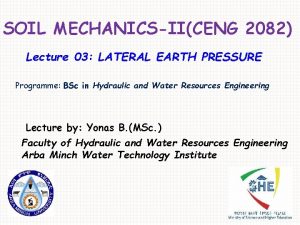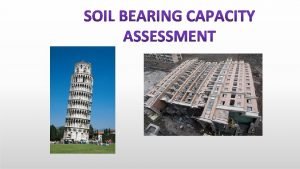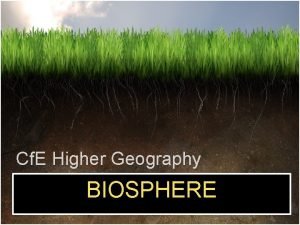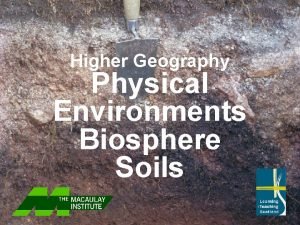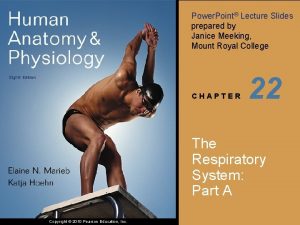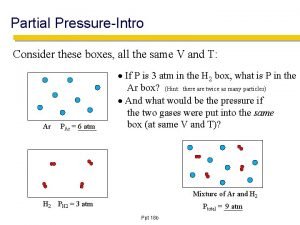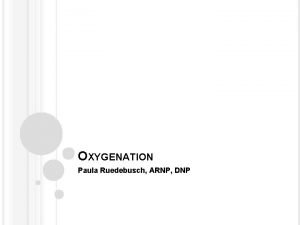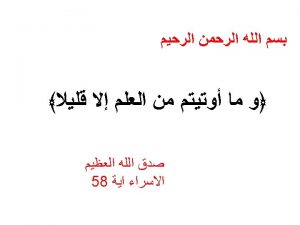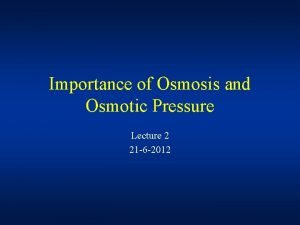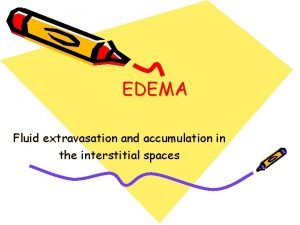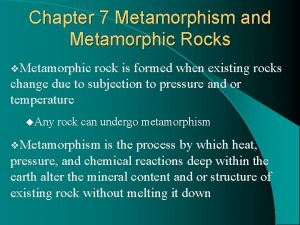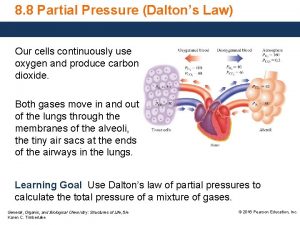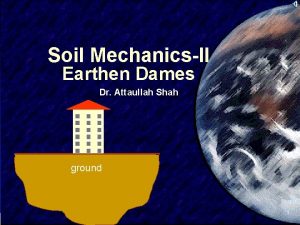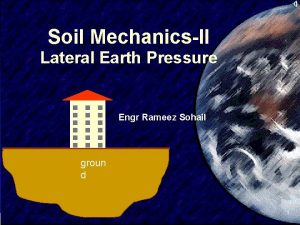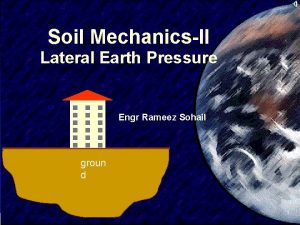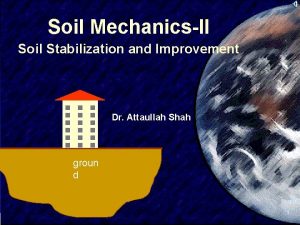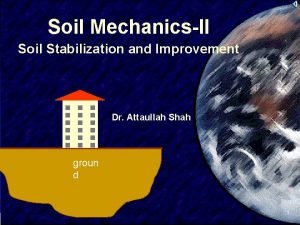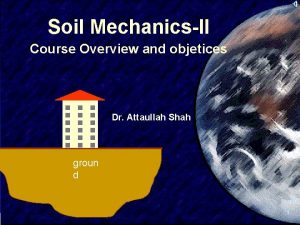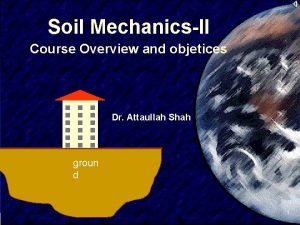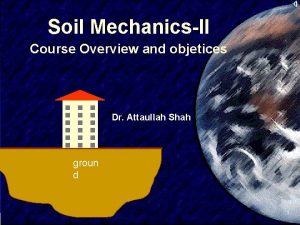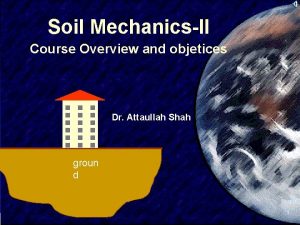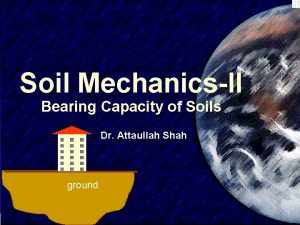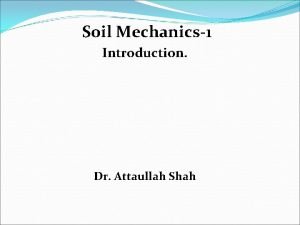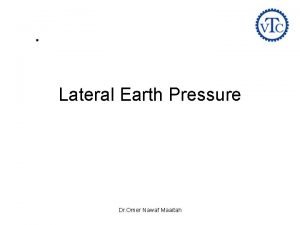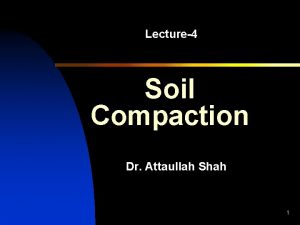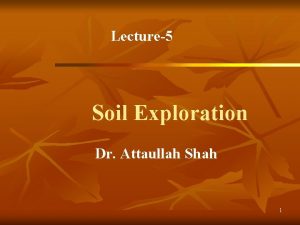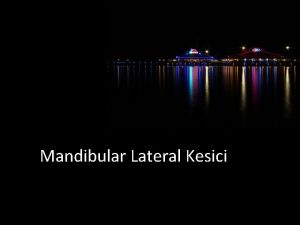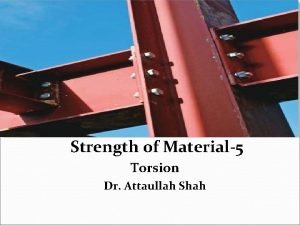Soil MechanicsII Lateral Earth Pressure Dr Attaullah Shah





























- Slides: 29

Soil Mechanics-II Lateral Earth Pressure Dr. Attaullah Shah groun d SIVA 1

Retaining Walls and Lateral Pressure n n Structures that are built to retain vertical or nearly vertical earth banks or any other material are called retaining walls. Retaining walls may be constructed of masonry or sheet piles. All the walls listed in Fig have to withstand lateral pressures either from earth or any other material on their faces. Gravity walls resist movement because of their heavy sections. They are built of mass concrete or stone or brick masonry. In all these cases, the backfill tries to move the wall from its position. The movement of the wall is partly resisted by the wall itself and partly by soil in front of the wall. 2

Various types of Retaining walls Principal types of rigid retaining walls 3

Active Earth Pressure n n A retaining wall backfilled with cohesion less soil shown in Fig. If the wall does not move even after back filling, the pressure exerted on the wall is termed as pressure for the at rest condition of the wall If suppose the wall gradually rotates about point A and moves away from the backfill, the unit pressure on the wall is gradually reduced and after a particular displacement of the wall at the top, the pressure reaches a constant value. The pressure is the minimum possible. This pressure is termed the active pressure since the weight of the backfill is responsible for the movement of the wall. If the wall surface is smooth, the resultant pressure acts normal to the face of the wall. If the wall is rough, it makes an angle б with the normal on the wall. The angle б is called the angle of wall friction. As the wall moves away from the backfill, the soil tends to move forward. 4

Active and Passive lateral pressure n n When the wall movement is sufficient, a soil mass of weight W ruptures along surface ADC shown in Fig (a). This surface is slightly curved. If the surface is assumed to be a plane surface AC, analysis would indicate that this surface would make an angle of 45° + ɸ/2 with the horizontal. If the wall is now rotated about A towards the backfill, the actual failure plane ADC is also a curved surface Fig (b). However, if the failure surface is approximated as a plane AC, this makes an angle 45° - ɸ/2 with the horizontal and the pressure on the wall increases from the value of the at rest condition to the maximum value possible. The maximum pressure P that is developed is termed the passive earth pressure. The pressure is called passive because the weight of the backfill opposes the movement of the wall. It makes an angle б with the normal if the wall is rough. 5

Lateral Earth Pressure at rest condition n n n If the wall is rigid and does not move with the pressure exerted on the wall, the soil behind the wall will be in a state of elastic equilibrium. Consider a prismatic element E in the backfill at depth z shown in Fig. Element E is subjected to the following pressures. бz= ɣz; lateral pressure =бh where ɣ is the effective unit weight of the soil. If we consider the backfill is homogeneous then both бz and бh increase linearly with depth z. In such a case, the ratio бz of ah to бh remains constant with respect to depth, that is where Ko is called the coefficient of earth pressure for the at rest condition or at rest earth pressure coefficient. The lateral earth pressure бh acting on the wall at any depth z may be expressed as бh = Koɣz and According to Jocky ( 1940) 6

Example n n If a retaining wall 5 m high is restrained from yielding, what will be the atrest earth pressure per meter length of the wall? Given: the backfill is cohesionless soil having ɸ= 30° and ɣ = 18 k. N/m 3. Also determine the resultant force for the at-rest condition. Solution: For soil at rest condition, the lateral coefficenet n 7

RANKINE'S EARTH PRESSURE AGAINST SMOOTH VERTICAL WALL WITH COHESIONLESS BACKFILL I. Backfill Horizontal-Active Earth Pressure n n n A semi-infinite mass is replaced by a smooth wall AB in Fig. The lateral pressure acting against smooth wall AB is due to the mass of soil ABC above failure line AC which makes an angle of 45° + ɸ/2 with the horizontal. The lateral pressure distribution on wall AB of height H increases in simple proportion to depth. The pressure acts normal to the wall AB The lateral active pressure at A is 8

II. Backfill Horizontal-Passive Earth Pressure n n n If wall AB is pushed into the mass to such an extent as to impart uniform compression throughout the mass, soil wedge ABC in Fig(a). will be in Rankine's passive state of plastic equilibrium. The inner rupture plane AC makes an angle 45° + ɸ/2 with the vertical AB. The pressure distribution on wall AB is linear as shown in Fig(b). The ratio of Kp and KA may be written as: 9

Active Earth Pressure-Backfill Soil Submerged with the Surface Horizontal n When the backfill is fully submerged, two types of pressures act on wall AB, as shown in Fig The active earth pressure due to the submerged weight of soil 2. The lateral pressure due to water 1. At any depth z the total unit pressure on the wall is At depth z = H, we have n where ɣb is the submerged unit weight of soil and ɣw the unit weight of water. The total pressure acting on the wall at a height H/3 above the base is 10

Active Earth Pressure-Backfill Partly Submerged with a Uniform Surcharge Load The soil upto depth H 1 is moist whereas Below this point for depth H 2 is submerged. At depth H 1 at the level of the water table n n At depth H we have the lateral pressure due to surcharge, the moist soil for depth H 1, the submerged soil for depth H 2 and water pressure for depth H 2. The total pressure Pa acting per unit length of the wall may be written as equal to: The point of application of Pa above the base of the wall can be found by taking moments of all the forces acting on the wall about A. 11

Solved Example n n A cantilever retaining wall of 7 meter height (Fig. Ex. 11. 2) retains sand. The properties of the sand are: e = 0. 5, ɸ = 30° and G = 2. 7. Using Rankine's theory determine the active earth pressure at the base when the backfill is (i) dry, (ii) saturated and (iii) submerged, and also the resultant active force in each case. In addition determine the total water pressure under the submerged condition. 12

13

14

Assignment n n A rigid retaining wall 5 m high supports a backfill of cohesionless soil with ɸ= 30°. The water table is below the base of the wall. The backfill is dry and has a unit weight of 18 k. N/m 3. Determine Rankine's passive earth pressure per meter length of the wall A counter fort wall of 10 m height retains a non-cohesive backfill. The void ratio and angle of internal friction of the backfill respectively are 0. 70 and 30° in the loose state and they are 0. 40 and 40° in the dense state. Calculate and compare active and passive earth pressures for both the cases. Take the specific gravity of solids as 2. 7. 15

COULOMB'S EARTH PRESSURE THEORY FOR SAND FOR ACTIVE STATE Coulomb made the following assumptions in n n n n the development of his theory: 1. The soil is isotropic and homogeneous 2. The rupture surface is a plane surface 3. The failure wedge is a rigid body 4. The pressure surface is a plane surface 5. There is wall friction on the pressure surface 6. Failure is two-dimensional and 7. The soil is cohesionless 16

n n n In Fig AB is the pressure face The backfill surface BE is a plane inclined at an angle ß with the horizontal α is the angle made by the pressure face AB with the horizontal H is the height of the wall AC is the assumed rupture plane surface, and θ is the angle made by the surface AC with the horizontal The weight of the wedge W length of the wall may be written as W = γA, where A = area of wedge ABC Area of wedge ABC = A = 1/2 AC x BD, where BD is drawn perpendicular to AC. From the law of sines, we have Making the substitution and simplifying we have, The various forces that are acting on the wedge are shown in Fig. a 17

n n n As the pressure face AB moves away from the backfill, there will be sliding of the soil mass along the wall from B towards A. The sliding of the soil mass is resisted by the friction of the surface. The direction of the shear stress is in the direction from A towards B. lf Pn is the total normal reaction of the soil pressure acting on face AB, the resultant of Pn and the shearing stress is the active pressure Pa making an angle δ with the normal. Since the shearing stress acts upwards, the resulting Pa dips below the normal. The angle δ for this condition is considered positive. As the wedge ABC ruptures along plane AC, it slides along this plane. This is resisted by the frictional force acting between the soil at rest below AC, and the sliding wedge. The resisting shearing stress is acting in the direction from A towards C. If Wn is the normal component of the weight of wedge W on plane AC, the resultant of the normal Wn and the shearing stress is the reaction R. This makes an angle ϕ with the normal since the rupture takes place within the soil itself. 18

n n n Statical equilibrium requires that the three forces Pa, W, and R meet at a point. Since AC is not the actual rupture plane, the three forces do not meet at a point. But if the actual surface of failure AC'C is considered, all three forces meet at a point. However, the error due to the non concurrence of the forces is very insignificant and as such may be neglected. The polygon of forces is shown in Fig. In Eq. , the only variable is θ and all the other terms for a given case are constants. Substituting for W, we have The maximum value for Pa is obtained by differentiating Eq. with respect to θ and equating the derivative to zero, i. e. The maximum value of Pa so obtained may be written as 19

Active earth pressure coefficients KA for ß=0 and α = 90 deg 20

n n where KA is the active earth pressure coefficient. The total normal component Pn of the earth pressure on the back of the wall is If the wall is vertical and smooth, and if the backfill is horizontal, we have ß=δ= 0 and α= 90 deg, Substituting these values in Eq. 21

n COULOMB'S EARTH PRESSURE THEORY FOR SAND FOR PASSIVE STATE As the wall moves into the backfill, the soil tries to move up on the pressure surface AB which is resisted by friction of the surface. Shearing stress on this surface therefore acts downward. The passive earth pressure P is the resultant of the normal pressure P and the shearing stress. The shearing force is rotated upward with an angle δ which is again the angle of wall friction. In this case S is positive. n As the rupture takes place along assumed plane surface AC, the soil tries to move up the plane which is resisted by the frictional force acting on that line. The shearing stress therefore, acts downward. The reaction R makes an angle ϕ with the normal and is rotated upwards as shown in the figure. The polygon of forces is shown in (b) of the Fig. n Differentiating Eq. with respect to θ and setting the derivative to zero, gives the minimum value of Pp as 22 where Kp is called the passive earth pressure coefficient.

n n n Eq. is valid for both positive and negative values of ft and 8. The total normal component of the passive earth pressure Pn on the back of the wall is For a smooth vertical wall with a horizontal backfill, we have n 23

ACTIVE PRESSURE BY CULMANN'S METHOD FOR COHESIONLESS SOILS Culmann's (1875) method is the same as the trial wedge method. In Culmann's method, the force polygons are constructed directly on the ϕ-line AE taking AE as the load line. The procedure is as follows: 1. Draw ϕ -line AE at an angle ϕ to the horizontal. 2. Lay off on AE distances, AV, A 1, A 2, A 3, etc. to a suitable scale to represent the weights of wedges ABV, A 51, AS 2, AS 3, etc. respectively. 3. Draw lines parallel to AD from points V, 1, 2, 3 to intersect assumed rupture lines AV, Al, A 2, A 3 at points V", I', 2', 3', etc. respectively. 4. Join points V, 1', 2' 3' etc. by a smooth curve which is the pressure locus. 5. Select point C‘ on the pressure locus such that the tangent to the curve at this point is parallel to the ϕ-line AE. 6. Draw C'C parallel to the pressure line AD. The magnitude of C'C in its natural units gives the active pressure Pa. 7. Join AC" and produce to meet the surface of the backfill at C. AC is the rupture line. For the plane backfill surface, the point of application of Pa is at a height of H/3 from the base of the wall. 24

25

Example: n For a retaining wall system, the following data were available: (i) Height of wall = 7 m, (ii) Properties of backfill: γd = 16 k. N/m 3, ϕ = 35°, (iii) angle of wall friction, 8 = 20°, (iv) back of wall is inclined at 20° to the vertical (positive batter), and (v) backfill surface is sloping at 1 : 10. Determine the magnitude of the active earth pressure by Culmann's method. (a) Fig. shows the ϕ line and pressure lines drawn to a suitable scale. (b) The trial rupture lines Bc 1 Bc 2, Bc 3 etc. are drawn by making Ac 1 = c 1 c 2= c 2 c 3, etc. (c) The length of a vertical line from B to the backfill surface is measured. (d) The areas of wedges BAc 1 BAc 2, BAc 3 etc. are respectively equal to l/2(base lengths Ac 1, Ac 2, Acy etc. ) * perpendicular length. (e). The weights of the wedges in (d) above per meter length of wall may be determined by multiplying the areas by the unit weight of the soil. The results are tabulated (f) The weights of the wedges BAc 1, BAc 2, etc. are respectively plotted are Bd 1 Bd 2, etc. on the ϕ-line. 26

n n n (g) Lines are drawn parallel to the pressure line from points d 1, d 2, d 3 etc. to meet respectively the trial rupture lines Bc 1 Bc 2, Bc 3 etc. at points e 1, e 2, e 3 etc. (h) The pressure locus is drawn passing through points e, e 2, ey etc. (i) Line zz is drawn tangential to the pressure locus at a point at which zz is parallel to the ϕ line. This point coincides with the point e 3 (j) e 3 d 3 gives the active earth pressure when converted to force units. Pa = 180 k. N per meter length of wall, (k) Bc 3 is the critical rupture plane. 27

STABILITY OF RETAINING WALLS 1. Check for sliding 2. Check for overturning 3. Check for bearing capacity failure 4. Check for base shear failure The minimum factors of safety for the stability of the wall are: 1. Factor of safety against sliding =1. 5 2. Factor of safety against overturning = 2. 0 3. Factor of safety against bearing capacity failure = 3. 0 28

Assignments n 1. 29
 Dr attaullah tutorial
Dr attaullah tutorial Soil pressure calculation
Soil pressure calculation Lateral earth pressure formula
Lateral earth pressure formula Lateral earth pressure formula
Lateral earth pressure formula Living soil vs dead soil
Living soil vs dead soil What are the four spheres of the earth
What are the four spheres of the earth Formula for a triangular prism surface area
Formula for a triangular prism surface area Boussinesq stress distribution
Boussinesq stress distribution The gross pressure intensity q of structure is
The gross pressure intensity q of structure is Higher geography biosphere
Higher geography biosphere Brown earths
Brown earths Podzol soil profile
Podzol soil profile Gley soil diagram
Gley soil diagram Pressure tolerant vs pressure sensitive
Pressure tolerant vs pressure sensitive Pressure support vs pressure control
Pressure support vs pressure control Pressure mapping for pressure ulcers
Pressure mapping for pressure ulcers Intrapulmonary pressure
Intrapulmonary pressure Oncotic pressure
Oncotic pressure How to find partial pressure from total pressure
How to find partial pressure from total pressure Intrapleural pressure vs intrapulmonary pressure
Intrapleural pressure vs intrapulmonary pressure Metamorphic
Metamorphic Pressure support vs pressure control
Pressure support vs pressure control Stagnation pressure formula
Stagnation pressure formula Oncotic pressure vs hydrostatic
Oncotic pressure vs hydrostatic Impermeance
Impermeance Low oncotic pressure
Low oncotic pressure Hydrostatic oncotic pressure
Hydrostatic oncotic pressure Metamorphism
Metamorphism How to calculate mean arterial pressure
How to calculate mean arterial pressure How to find partical pressure
How to find partical pressure


